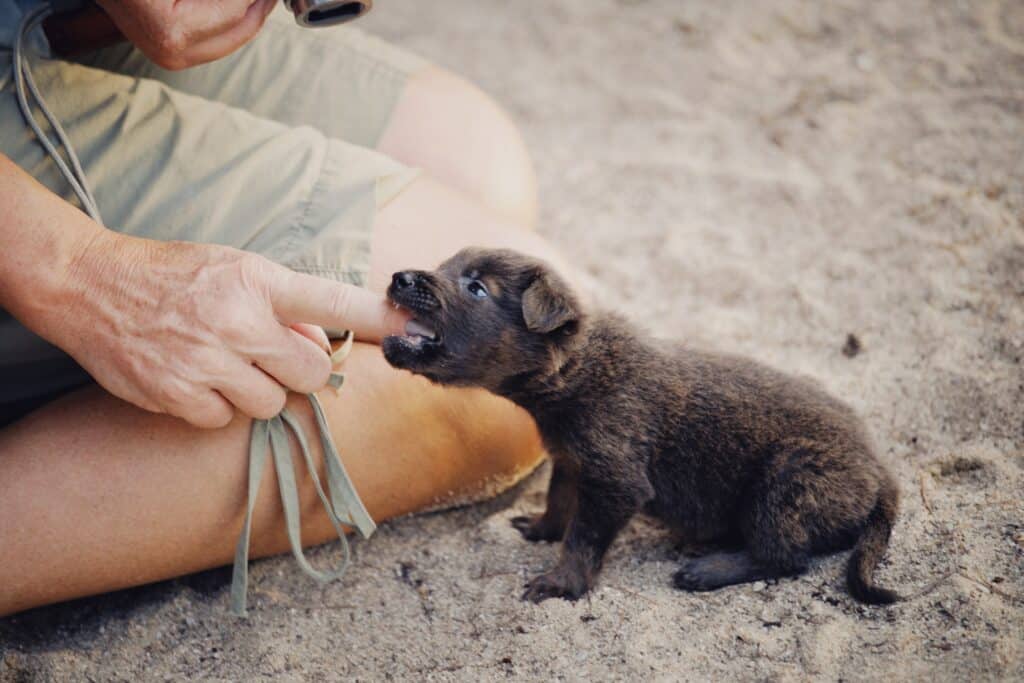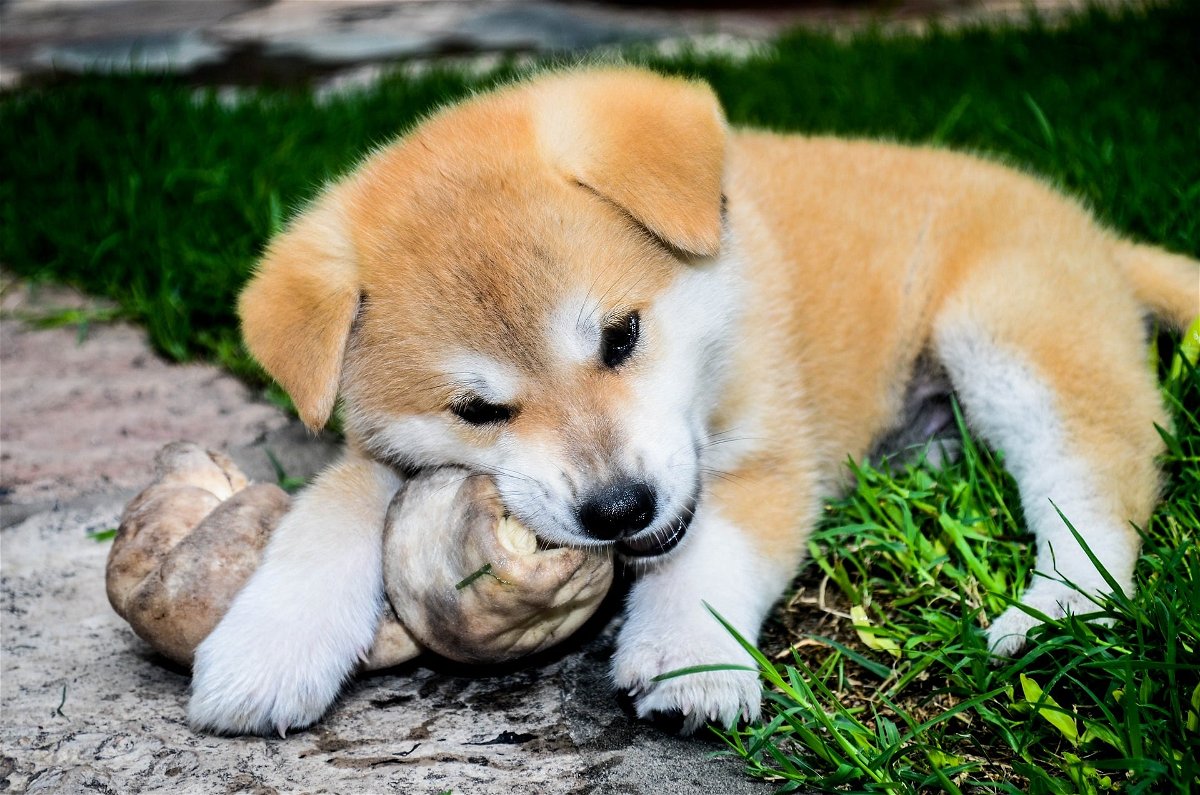We're an affiliate
We hope you love the products we recommend! Just so you know, we may collect a share of sales or other compensation from the links on this page at no additional cost to you. Thank you if you use our links, we really appreciate it!
Dogs have a natural instinct to chew on bones and it is good for their physical health and mental well-being.
When can puppies start chewing bones is a crucial question that any pet parent should engage in before handing over a bone to their little pooch.
Can Puppies Have Bones?
Yes. Chewing on bones helps puppies relieve gum pain during the teething stage, prevents destructive chewing, makes them happy, and yes, it is delicious too!
Puppies are equally inclined to gnaw on bones but you need to know the right time and type of bone to give them.
Puppies have different teething stages, jaw maturity levels, and chewing habits. You, therefore, need to consider their individual personality before giving them a chew bone.
Follow us along as we highlight all that you need to know about puppy chewing habits and traits. Watch out for our guide on the best bones to give your little pups.
When Puppies Can Start Chewing Bones
Puppies can start chewing on bones from as early as 4 – 6 months of age depending on how fast they mature.
We generally recommend that you introduce bones to your puppy when they have completed their teething cycle; this is approximately when they are 6 months old.
Make sure to give your young pooch a bone that is larger than their muzzle to prevent them from swallowing the whole bone.

Remember that your puppy’s teeth are very fragile and therefore you need to find the best-textured bone for their easy chewing. The item should also be soft and tender depending on their teeth’ strength and jaw power.
You should always introduce bones to your furry friend slowly and with close supervision. Real bones have more benefits than chew toys but we recommend starting your puppy on soft chews as you progress to the real item.
Risks Of Giving Your Puppy Bones Before the Right Time
If you give your little Pomeranian some bones to chew before the right time, you are definitely putting more risks than benefits to them.
These negative consequences are a result of fragile and undeveloped teeth coupled with the little pooch’s inexperience in chewing.
Their juvenile teeth are not strong enough to handle any bone. If they try to chew, they risk fracturing their teeth leading to dental, mouth, and gum injuries.
Innocent puppies may try to swallow a small splinter of bone and this might lead to choking and intestinal blockage.
If your puppy has fully developed their teeth, we recommend that you visit the vet for a more elaborate greenlight on when and how to give your dog a raw bone.
Developmental Stages of Puppies
Teething in puppies
Puppies, just like human babies, will undergo a teething process that involves the baby teeth popping up, falling out, and giving way to the permanent adult teeth.
Between the 2nd and the 4th week, you should expect your puppy to start popping out their baby teeth. This is the period when the puppy comes to life in many aspects; their eyes would also open during this period.
By their 6th week, you will probably see all their razor-sharp primary teeth which should be around 28 in number.
During this stage, your puppy’s gums will become sore and sensitive due to the actions of the adult teeth pushing out the fragile milk teeth.
It is common for puppies to drool and nib on items during the process in an attempt to soothe the discomfort around the gum line.
It is during this time that your pup can chomp on anything they lay their jaws on, including your shoes, and the furniture, or even nibble your legs.

Even though this is normal behavior, you should pay attention and look out for signs of puppy gums bleeding when chewing bone or oral injury. If you notice anything abnormal, you should visit your vet for diagnosis and treatment.
The teething stage is a gradual process and it takes around 6 months for your puppy to shed off all their deciduous teeth and develop new 42 adult teeth.
You may periodically collect the fallen teeth from the floor during the teething cycle and your puppy might swallow some as well.
If your dog still has baby teeth at 8 months old, you need to visit your vet for professional teeth extraction.
Impact of teething and jaw maturity on chewing
The teething stage and jaw maturity process will affect how your puppy chews on items including bones and toys.
A puppy with fragile primary teeth and less mature jaws cannot handle a chew bone and when they try, it could only lead to dental and oral injuries.
This is why you should wait for your little dog to have their teeth fully developed before giving them any form of bone or hard toy to chew.
As the puppy grows, their teeth and jaws will also become stronger and this will allow them to chew on harder objects.
However, you should never be in a hurry to give your dog a chew bone. Always look out for the best types to match your puppy’s ability to chew.
5 Factors to Consider When Introducing Bones to Puppies
Before handing your little pup a chew bone, you need to be aware of the various factors to consider. A wrong bone could be a nightmare for your pup, so it is important to find out the most appropriate one.
1. The size and texture of the bone
Most pet parents would be tempted to give their puppy a small bone fragment because they’re young and it seems okay to do so.
This can be dangerous when your puppy tries to swallow the whole piece and ends up choking. Always get a large bone bigger than your puppy’s muzzle.

The texture of the bone toys should also be smooth to enable them to chew with ease. We recommend that you start with soft bone chews as you progress to raw bones when the dog gets much stronger teeth and jaws.
2. Supervision
Don’t leave your puppy to chew on bones without your close supervision and guidance. You can take this time to train your puppy on how to chew and take the bone away when they’ve gotten enough.
Being close to your puppy allows you to prevent them from trying to splinter the bone into pieces and trying to swallow a fragment.
A good point is to limit the chewing time to a maximum of 15 minutes per session.
3. Nutritional needs
What are the nutritional needs of your little pooch? Do you need to add more proteins or do you want to cut down on fat?
Knowing your puppy’s dietary needs will help you choose the right bones for their nutritional support. We recommend that you go for bones that are packed with healthy proteins, vitamins, and vital minerals.
You can always get in touch with your canine nutritionist for expert advice about your dog’s dietetic needs and how you can tweak their daily foods to include bones.
4. Avoid cooked bones
Don’t give your puppy a yummy bone straight from your dining table to their food bowl. The temptation is always there especially when the puppy gives you that smirking look below the table.
Cooked bones can easily be splintered and swallowed by the innocent young dog. This could expose them to mouth injuries, choking, and intestinal blockage which can be dangerous if not handled in time.
You should always start with bone toys and progress to raw meat bones when introducing your puppy to chewing.
Cooked bones are also deprived of some nutrients and minerals that are good for dogs, so it is just best to keep them off.
5. Chewing habits
Different dog breeds have different chewing habits. Some large dogs like Pitbulls and Labrador retrievers will chew more aggressively than toy breeds like chihuahuas or Yorkie Poos.
You should therefore match up your dog’s tendency to chew with the type of bone you introduce them to. This will help prevent excessive chewing, early bone deterioration, and possible dental issues.
Recommended: 13 Best Dog Bones for Aggressive Chewers
Recommended Types of Bones for Puppies
You should start your puppy on an easy-to-chew bone when their adult teeth have popped out. These are some of the safe options to consider depending on their growth stage:
1. Nylabones
A good option to consider is the Nylabones and bully sticks. You can get these types of bones specifically made for puppies during their teething stage.
When buying these teething sticks, you should always consider those that have been made with natural ingredients with no preservatives.
2. Raw poultry bones
As your puppy’s teeth become stronger, you can introduce them to real chicken and turkey bones.
These are softer than real beef bones and therefore your little pup will not be at risk of hurting their new set of teeth when chewing softly.
You can always feel the texture of the bone and decide if they’re a good fit for your little pup. Not all products made for puppies can be good for yours. Try a few more options and stick to that which worked out.
In Conclusion
On the question of when can puppies start chewing bones, it is best to start them at 4 to 6 months depending on their teething and development.
You should always instill proper chewing habits in little dogs to help them grow up to become responsible adults; by not chewing your stuff.
What better way to introduce proper chewing habits to dogs than using a yummy bone? Keep in mind the factors to consider when giving them a bone and take the process slowly.
Don’t forget to closely monitor your puppy when they’re chewing to prevent them from trying something fishy.
Laura is the founder of Furs'n'Paws. She is a also a pet writer and expert with more than 20 years of experience of working with dogs and cats. She developed a very strong love for animals at a young age. Her passion led her to establish a thriving pet sitting and dog walking business in Dubai. As an expert in pet training, behavior, and nutrition, Laura is committed to helping pet owners and pet lovers by offering high-quality information on a wide range of topics.



No responses yet